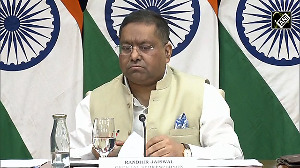Before the US Senate vote in September, India would have advanced its negotiations with the International Atomic Energy Agency to finalise the India-specific safeguards agreement. Indian critics of the deal, from the Left and the Right, have stridently criticised the deal citing that it attaches various binding and non-binding US stipulations.
These criticisms, however, are based on half-truths and on projections that cannot be supported by facts, and hence need to be refuted.
Limits on India's Enrichment and Reprocessing Programme
US President George W Bush stated (before his New Delhi visit) that India would be the recipient of nuclear fuel but not be allowed to enrich or reprocess this imported nuclear fuel. This would ensure that the Indian weapons programme does not benefit from external cooperation in any way.
This is in line with the core rationale of the July agreement, and does not constitute a new condition imposed by the United States. Further, this caveat in no way stops India's programme of enrichment and re-processing of its own uranium. India's separation plan does not place its reprocessing and centrifuge facilities under safeguards. Therefore, the different expectations about foreign fuel and Indian fuel should not be lumped together in this cavalier fashion.
Limitless Intrusiveness of the IAEA Additional Protocol
Some critics argue that the IAEA Additional Protocol would impose 'unbridled examination of each and every aspect of India's nuclear programme, compromising its exclusive technical know-how. Separating the military programme would not be that simple under this model protocol as the IAEA would have the right to go back to the past when the programs were not separate.'
This hyperbole cleverly omits the fact that the Additional Protocol would apply only after the military components of a facility have been separated. Moreover, this interpretation of Additional Protocol's powers is based on a fundamental ignorance of safeguards and of Additional Protocol objectives.
With the Non Nuclear Weapons States the Additional Protocol adds to IAEA's investigatory powers by tasking it to unearth any hidden (undeclared) nuclear activities anywhere in the country.
An India-specific safeguards agreement, precisely because India has declared weapons facilities, would not need to unearth such facilities. Under the terms of the deal, IAEA will begin by accepting India's baseline declarations of what exists in a particular civilian facility and what processes will utilise the input (fuel and equipment) and turn it into output (nuclear energy).
IAEA will then track this material and technology within the safeguarded fuel cycle as declared by India. The intrusiveness of Additional Protocol conditions will attach only to the extent that the declarations by India for a particular facility do not match the actual observable situation, or if it appears that materials from a safeguarded facility have gone to an unsafeguarded facility -- whether newly discovered or not.
This problem should not arise if Indian experts do their job of preparing baseline declarations with foresight and accuracy.
On Testing and FMCT
The non-binding 'sense of the House' clauses in US Congressional Bills would mean annual certification (or reporting) and Congressional oversight. But this cannot become a problem unless India veers away sharply from its established policies of voluntary moratorium on testing and a steady expansion of its arsenal till it reaches the 'credible minimum' stage.
If India does decide to test, it will have sound national security reasons to do so. At that time, one would expect India to be prepared to bear any negative fallout -- not only on the nuclear industry but also on all other strategic relationships. In the meantime, it would be in the national security interest for the Indian government to define its credible minimum deterrent more precisely.
An open-ended weapons programme raises doubts in the international community about India's peaceful intentions or that it still supports universal disarmament. This alone will end the smoke and mirrors game being played by unnamed scientists fighting for or against the deal by claiming that Indian fissile stockpiles are 'enough' or 'will be enough shortly' or are 'totally inadequate'.
In the absence of a 'credible range' of weapons desired by the government, this bickering can be endless since it would not require either side to provide supportive evidence.
Further, those who believe that the United States is interested in fast tracking the negotiations for a Fissile Material Cut-off Treaty need to understand this US debate more fully.
Much like the divisions on the CTBT, the US policy community is deeply divided about the verifiability of such a treaty. Notwithstanding the pious proclamations by pro-FMCT US Congressmen, there is no majority support to ensure the smooth passage of the FMCT anytime in the near future.
Continuing the Discrimination on N-Technology
Critics charge that 'the fuel cycle and all equipment and technologies for the fuel cycle including various dual use technologies would continue to remain under sanctions.'
However, if India is sure that it has mastered the complete fuel cycle, then why should this stipulation matter?
Presumably, the deal only facilitates scaling up of nuclear energy production by building new and higher-output nuclear power plants and ensuring supply of fuel to feed these reactors. For the rest, the Indian programme needs no outside assistance -- nor should it expect to.
Some critics would like to see India oppose the proposed controls on fuel cycle capabilities among other Non Nuclear Weapons States because it would be discriminatory. They need to understand two facts. First, it was the Non Nuclear Weapons States -- which included both developed and developing States -- who sided with the Nuclear Weapons States to insert the Entry-Into-Force clause into CTBT despite principled Indian objections.
Indian tests in 1998 were criticised by fellow Non Alignment Movement members and even now, very few of them have supported the US argument that India's exceptional record on horizontal nonproliferation (not sharing its weapons technology) should make it eligible for some exemptions from the regime principles. India is still equated with Pakistan by these States.
Second, the Nuclear Weapons States' proposal seeks to limit enrichment and re-processing capabilities to States that already have them, asking that they not share it with other Non Nuclear Weapons States. India already has this technology. For once, it stands to be among the haves rather than among the have-nots.
In sum, the debate on the nuclear deal should be based on facts and not on knee-jerk nationalism or internationalism.
Dr Seema Gahlaut directs the South Asia programme at the Centre for International Trade and Security, University of Georgia, USA.
Complete coverage: The Nuclear deal | The Nuclear chats







 © 2025
© 2025